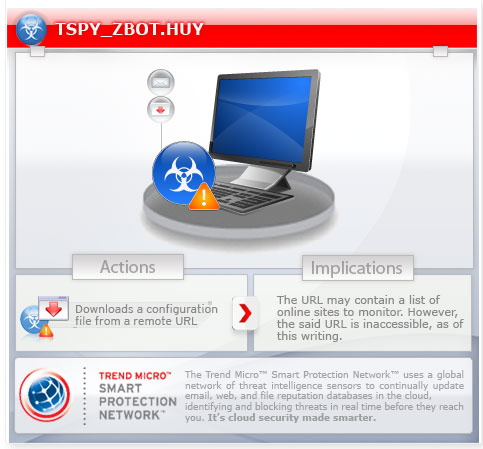TSPY_ZBOT.HUY
Windows 2000, Windows XP, Windows Server 2003


Threat Type: Spyware
Destructiveness: No
Encrypted: Yes
In the wild: Yes
OVERVIEW
This malicious file disguises itself as a phishing report supposedly from the United States Computer Emergency Readiness Team or US-CERT.
To get a one-glance comprehensive view of the behavior of this Spyware, refer to the Threat Diagram shown below.

This spyware arrives as an attachment to email messages spammed by other malware/grayware or malicious users. It may be unknowingly downloaded by a user while visiting malicious websites.
It does not have any propagation routine.
It modifies the Internet Explorer Zone Settings.
It terminates itself if it detects it is being run in a virtual environment.
TECHNICAL DETAILS
237,056 bytes
EXE
Yes
10 Jan 2012
Downloads files
Arrival Details
This spyware arrives as an attachment to email messages spammed by other malware/grayware or malicious users.
It may be unknowingly downloaded by a user while visiting malicious websites.
Installation
This spyware drops the following files:
- %Application Data%\{random2}\{random}.{random ext}
(Note: %Application Data% is the current user's Application Data folder, which is usually C:\Windows\Profiles\{user name}\Application Data on Windows 98 and ME, C:\WINNT\Profiles\{user name}\Application Data on Windows NT, and C:\Documents and Settings\{user name}\Local Settings\Application Data on Windows 2000, XP, and Server 2003.)
It drops the following copies of itself into the affected system:
- %Application Data%\{random1}\{random}.exe
(Note: %Application Data% is the current user's Application Data folder, which is usually C:\Windows\Profiles\{user name}\Application Data on Windows 98 and ME, C:\WINNT\Profiles\{user name}\Application Data on Windows NT, and C:\Documents and Settings\{user name}\Local Settings\Application Data on Windows 2000, XP, and Server 2003.)
It creates the following folders:
- %Application Data%\{random1}
- %Application Data%\{random2}
(Note: %Application Data% is the current user's Application Data folder, which is usually C:\Windows\Profiles\{user name}\Application Data on Windows 98 and ME, C:\WINNT\Profiles\{user name}\Application Data on Windows NT, and C:\Documents and Settings\{user name}\Local Settings\Application Data on Windows 2000, XP, and Server 2003.)
Autostart Technique
This spyware adds the following registry entries to enable its automatic execution at every system startup:
HKEY_CURRENT_USER\Software\Microsoft\
Windows\CurrentVersion\Run
{GUID} = "%Application Data%\{random1}\{random}.exe"
Other System Modifications
This spyware adds the following registry keys as part of its installation routine:
HKEY_CURRENT_USER\Software\Microsoft\
{random}
Propagation
This spyware does not have any propagation routine.
Web Browser Home Page and Search Page Modification
This spyware modifies the Internet Explorer Zone Settings.
Download Routine
This spyware connects to the following URL(s) to download its configuration file:
- http://{BLOCKED}lunch.ru/stone2012.php
Other Details
This spyware terminates itself if it detects it is being run in a virtual environment.
NOTES:
Its configuration file is inaccessible as of this writing.
SOLUTION
9.200
8.700.07
10 Jan 2012
8.701.00
11 Jan 2012
Step 1
For Windows XP and Windows Server 2003 users, before doing any scans, please make sure you disable System Restore to allow full scanning of your computer.
Step 2
Scan your computer with your Trend Micro product and note files detected as TSPY_ZBOT.HUY
Step 3
Restart in Safe Mode
Step 4
Delete the registry entry with an unknown data value
Important: Editing the Windows Registry incorrectly can lead to irreversible system malfunction. Please do this step only if you know how or you can ask assistance from your system administrator. Else, check this Microsoft article first before modifying your computer's registry.
- In HKEY_CURRENT_USER\Software\Microsoft\Windows\CurrentVersion\Run
- {GUID} = %Application Data%\{random1}\{random}.exe
- {GUID} = %Application Data%\{random1}\{random}.exe
Step 5
Search and delete this file
- %Application Data%\{random2}\{random}.{random ext}
Step 6
Search and delete these folders
- %Application Data%\{random1}
- %Application Data%\{random2}
Step 7
Restart in normal mode and scan your computer with your Trend Micro product for files detected as TSPY_ZBOT.HUY. If the detected files have already been cleaned, deleted, or quarantined by your Trend Micro product, no further step is required. You may opt to simply delete the quarantined files. Please check this Knowledge Base page for more information.
NOTES:
The created registry key HKEY_CURRENT_USER\Software\Microsoft\{random} cannot be identified by the users since there are no reference values in the created key. The only way it can be identified is by comparing the present keys with a backup if the users have one. Note that the key, {random} need not to be deleted since it won't cause the user system any harm.
In deleting the created folders, please take note of the malware path of the file(s) detected earlier.
Did this description help? Tell us how we did.


